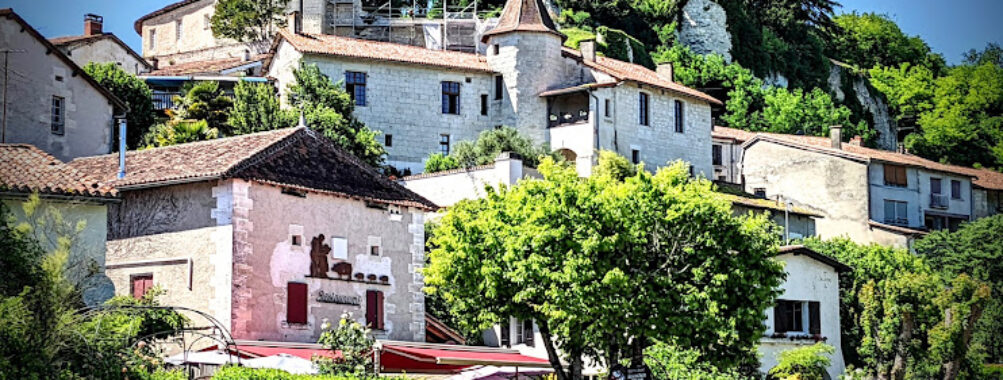
Charente
Table of Contents
Description
There’s something quietly magnetic about the Charente. Tucked into the heart of southwestern France, this department feels like a place where time has politely slowed down—just enough for you to catch your breath between sips of Cognac and strolls through sunflower fields. The Charente takes its name from the river that winds lazily through its valleys, connecting the region’s two most famous towns: Angoulême and Cognac. Both places carry their own charm—Angoulême with its comic art murals and hilltop views, and Cognac with its world-famous distilleries that perfume the air with that deep, sweet aroma of aging brandy.
What makes the Charente special isn’t just its postcard-perfect scenery (though there’s plenty of that). It’s the rhythm of life here—unhurried, warm, and full of small pleasures. You might find yourself chatting with a cheesemonger in a village market, cycling through vineyards that stretch to the horizon, or sitting at a café terrace watching the light shift across old limestone walls. It’s the kind of place that doesn’t show off, but quietly wins you over.
I still remember my first visit—sitting by the river near Jarnac, the water so still it mirrored the sky. There was a faint buzz of bees and the occasional distant church bell. Nothing dramatic, just a moment that made me think, “Yeah, this is what peace feels like.” That’s the Charente in a nutshell: understated, genuine, and deeply French.
Key Features
- Historic towns: Angoulême’s medieval ramparts and Cognac’s cobbled streets tell stories of centuries past.
- World-famous Cognac houses: Visit distilleries like Hennessy or Rémy Martin for tours and tastings that reveal the craft behind the spirit.
- Scenic river valleys: The Charente River offers canoeing, riverside picnics, and tranquil boat rides.
- Romanesque architecture: Dozens of small churches and abbeys dot the countryside, each with its own quiet beauty.
- Local gastronomy: Think goat cheese, duck confit, pineau des Charentes, and market-fresh produce that tastes like sunshine.
- Outdoor activities: Cycling routes, hiking trails, and gentle countryside roads make exploring easy and rewarding.
- Festivals: Angoulême’s International Comic Festival and Cognac Blues Passions draw visitors from around the world.
Best Time to Visit
If you’re after warm weather and lively markets, late spring through early autumn (May to September) is prime time. The summer months bring long, golden evenings and plenty of outdoor events, though July and August can get a bit busy around Angoulême and Cognac. Personally, I love September here—the grapes are being harvested, the air smells faintly of fruit and oak, and the pace slows just enough to feel like you’ve got the place to yourself.
Winter, on the other hand, has its own charm. The mornings are misty, the cafés are cozy, and locals have more time to chat. If you’re not afraid of a little chill, it’s a great time to experience the region without the crowds. Just bring a warm coat and an appetite for hearty French stews.
How to Get There
The Charente is surprisingly easy to reach. Most travelers arrive via the nearby city of Bordeaux, which has an international airport and high-speed train connections. From there, it’s about a 90-minute drive to Angoulême or Cognac. You can also catch a direct TGV (high-speed train) from Paris to Angoulême in roughly two hours, which makes it an easy weekend escape.
Once you’re here, renting a car is a good idea. Public transport between small villages is limited, and driving lets you explore those hidden corners—the little hamlets with stone cottages and bakeries that smell like heaven. Just be warned: the roads are narrow, and locals drive with a kind of confident ease that might take a few minutes to get used to.
Tips for Visiting
First off, don’t rush. The Charente isn’t a “checklist” destination—it’s a place to wander, taste, and linger. Take your time exploring the backroads; some of the best discoveries happen when you turn off the main route and follow a sign to a village you’ve never heard of.
If you’re planning to visit Cognac’s distilleries, book ahead—especially in summer. Many offer guided tours that include tastings, and those spots fill up fast. And trust me, even if you’re not usually a spirits fan, seeing how Cognac is made (and aged) is fascinating.
Bring comfortable shoes. Between exploring Angoulême’s steep streets and walking through vineyards, you’ll be on your feet a lot. And if you’re cycling, carry water and sunscreen—the sun here can be surprisingly strong, even in spring.
A small but important tip: learn a few French phrases. People in the Charente are friendly, but English isn’t always spoken in rural areas. A simple “Bonjour” or “Merci” goes a long way and often leads to a smile or a friendly chat.
Lastly, keep an ear out for local markets. They’re a highlight of life here—baskets of fresh figs, wheels of cheese, and the kind of bread that makes you question everything you thought you knew about baguettes. Go early, bring cash, and don’t be shy about sampling.
The Charente doesn’t shout for attention, and that’s exactly why travelers fall in love with it. It’s a place that rewards curiosity and patience. You come for the Cognac and countryside, but you stay for the feeling—the sense that life here moves at just the right speed. And when you leave, you’ll probably find yourself already planning the next trip back.
Location
Places to Stay Near Charente
Find and Book a Tour
Explore More Travel Guides
No reviews found! Be the first to review!